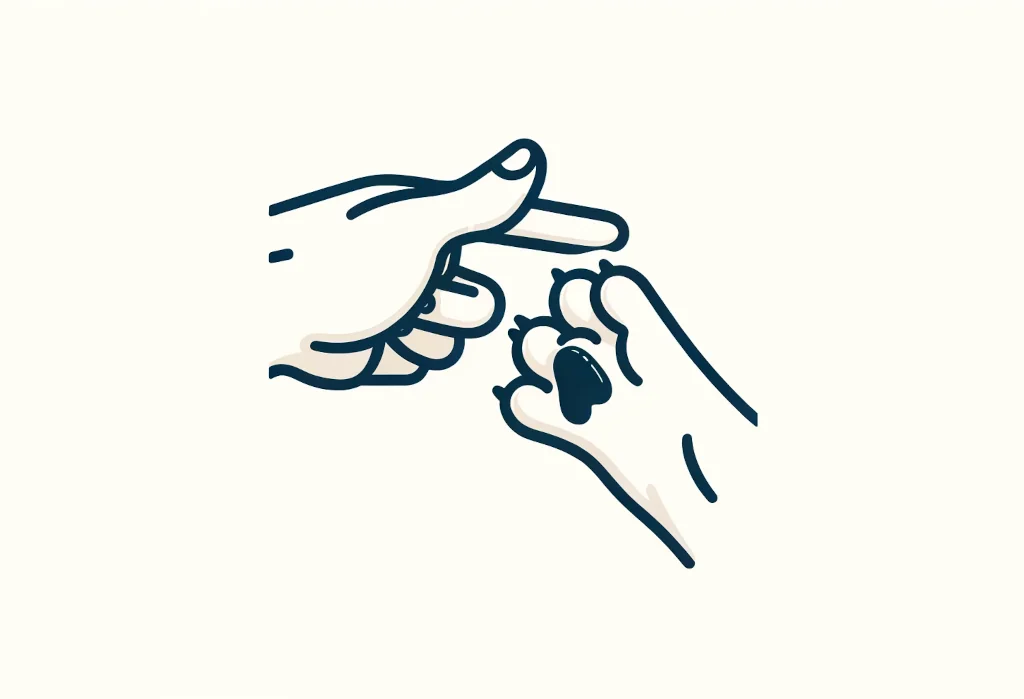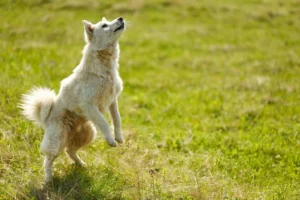When your furball looks at you with those I’ll-do-anything-for-a-treat eyes, it’s hard to resist not teaching them every trick in the book. But let’s hone in on one that’s as fun as it is useful – the ‘Touch’ command.
By the end of this read, you’ll be equipped to turn those eager eyes into focused, touching triumph.
Key takeaways:
- Equip yourself with irresistible treats and use the word “Touch” consistently to teach your dog to nuzzle your hand on command.
- Reward your dog immediately after a successful touch to reinforce the behavior, and vary rewards to maintain interest.
- Practice in short, engaging sessions throughout the day and integrate the Touch command into routine activities for practical learning.
Why Teach the Touch Command?
There’s a heap of benefits when it comes to teaching your furry pal the Touch command.
Firstly, it sharpens their focus. Dogs are naturally curious creatures, and Touch can help redirect their attention back to you when distractions are rife. It’s like a game for their brain, giving them a dose of mental stimulation that’s as satisfying as a belly rub.
Moreover, Touch is an ace up your sleeve for reinforcing that special bond between you two. Each time your pup nudges your hand with their nose, it’s an interaction that builds trust and teamwork. And let’s not forget, it’s a fantastic foundation for more tricky maneuvers down the road – after all, every great act starts with a single touch.
What Equipment Do You Need to Start Training?
Before you dive into training, let’s chat about the gear you’ll need. Spoiler alert – it’s not much. Grab some mouth-watering treats that your dog finds irresistible. Think of these tidbits as your dog’s salary for a job well done. You’ll also want a quiet nook free of distractions. This can be any serene spot in your home where your dog feels comfy – no need for a circus tent or a magic wand. That’s it. No fancy gizmos or gadgets; simplicity is key here.
How Do You Introduce the Touch Command?
Now, roll up your sleeves and let’s get down to brass tacks. First up, you need a signal that says “it’s go-time” for Touch. Many folks use the word “Touch,” but feel free to jazz it up if you’re feeling whimsical – just keep it consistent.
- Kick things off by making sure you have your dog’s attention. Hold out your hand, palm facing your pooch, close but not too close – just a teaser.
- Next up, say your magic word (“Touch” or your personal spin). The moment those wet whiskers graze your palm, it’s party time – let the treats rain! You’re rewarding the behavior, making it crystal clear that a nose boop equals tasty dividends.
- Keep practicing, gradually upping the ante. Start with your palm close, and as your dog becomes a Touch maestro, extend your reach. It’s like stretching their brain muscles – in a good way.
- Mix it up — practice in different spots around the house or even outside. Variety is the spice of life, after all.
- A pro tip: occasionally use a non-treat reward like a belly scratch or a game of tug when they nail it. This ensures your pal doesn’t only work when the snack cupboard’s open.
Remember, patience is the name of the game. Keep sessions short and sweet to prevent any doggie frustration or overload. Little by little, you’re not just teaching a command; you’re schooling your pooch in patience, precision, and eagerness to please.
And here’s something you won’t see on every blog: for an added twist, once your dog’s got the hang of it, start associating the Touch command with other daily routines. Get them to “Touch” before mealtime, which can help in situations where you need your dog to focus before doing something important. It turns a simple command into a multifaceted tool – handy, isn’t it?
Keep in mind, our journey with the Touch command doesn’t end here. Like a good book, there are more pages to turn, fostering a deeper learning curve for both you and your pup. Stay tuned for more insights and tips on training and bonding with your canine companion.
What’s the Best Way to Reward My Dog?
When you watch your furry friend’s eyes light up during training, you know the power of a well-timed reward. Positive reinforcement is the key to molding your dog’s behavior, and the Touch command is no exception. You’re aiming for the sweet spot—rewarding right as your dog’s nose bumps your hand. This tells Rover, “You nailed it!”
Here’s the scoop on rewarding your pooch:
- Timing Is Everything: The reward should follow the Touch almost instantly. Delayed reactions can lead to confusion. Your dog might not connect the treat with the action you’re asking for.
- Variety Is the Spice of Life: Mix up treats with praise, pets, and playtime. Some days, a hearty “Good boy!” will do the trick, and others, a game of tug-of-war is the best jackpot.
- Keep It Healthy: Treats are a delight, but they should also be nutritious. Steer clear of over-feeding with high-calorie rewards—your dog’s waistline will thank you.
- Reward Consistency: Always reward the initial successes. Once your dog is a Touch pro, you can switch to intermittent rewards to keep them guessing and engaged.
Don’t shy away from enthusiastic praise. Dogs can read our tone and body language; they love knowing they’ve done a good job. So once Fido performs that perfect touch, light up like the Fourth of July!
How Can You Use Touch to Teach Other Commands?
Once your canine companion has the Touch command down pat, the two of you are ready to tackle new peaks together. Touch is a fabulous foundational command, opening up a world of possibility.
- Targeting: Use Touch to teach your dog to turn lights on and off, close doors, or ring a bell to go outside. They’ll touch their nose to different objects on cue.
- Heeling: Transition from Touch to teaching your dog to heel. Start by having them touch your hand while you’re standing still, then gradually move your hand to your side as you walk together.
- Agility Training: In agility courses, a Touch command can be a hidden ace. You can direct your dog to specific points or obstacles with precision.
A neat trick to work toward is the “Clean Up” game—teach your four-legged friend to touch toys and then drop them into a toy box. Not only is it impressive, but it also makes tidying up a breeze!
When Should You Practice the Touch Command?
Practicing the Touch command can be woven into your regular routine effortlessly. Still, it’s crucial to maintain a balance. Here’s how to integrate training into your day-to-day without much fuss:
- Morning Ritual: Have a quick session after breakfast. It’s a peaceful time to train, plus it starts the day on a positive note for both of you.
- Walkies Time: Before or after walks, have Fido touch your hand to reinforce good behavior.
- Commercial Breaks: Watching TV? Those two-minute ad breaks are perfect training intervals.
- Random Rewards: Occasionally ask for a Touch out of the blue and reward accordingly. It keeps the command fresh in your dog’s mind.
Remember to keep sessions short but sweet. Five to ten minutes is plenty—short enough to hold their attention, long enough to make progress.
An insider tip? Always end on a high note. If you sense your pal’s enthusiasm dipping, wrap up with a successful touch and a jackpot reward. That way, they’ll be wagging their tail before the next session even starts.
In weaving these techniques into your training, you’ll not only bond with your dog but also enrich their life with stimulating activities. Training should be a joy, not a chore—for both of you. So, keep sessions upbeat and watch as your four-legged Einstein grows smarter by the day.
Troubleshooting Common Issues
Sometimes training sessions with your furry friend might hit a snag. So, what do you do when your pooch seems more interested in chasing a squirrel than learning the Touch command? Don’t fret! Let’s dig into some typical bumps in the road and steer you back on track with practical solutions.
Dog Losing Interest It’s not unusual for a dog to lose interest during training. Remember, repetitive exercises can be as dull for dogs as they are for humans. Keep things fresh and engaging with these tips:
- Short and Sweet: Keep training sessions short. A 5 to 10-minute session a couple of times a day is plenty to keep their brain buzzing without burning them out.
- High-Value Treats: Use treats that’ll have your dog drooling with anticipation. Whether it’s chicken, cheese, or something else delightful, save these ‘jackpot’ treats for training times.
- Variety is the Spice of Life: Mix up your training routine. Once they’ve got the hang of Touch, intersperse it with other commands or tricks they know to keep them on their paws!
Dealing with Distractions If your buddy is constantly distracted, you’re not alone! Distractions are a normal part of a dog’s world. But there’s hope:
- Start Simple: Begin in a quiet, familiar environment to establish a foundation without the buzz of distractions.
- Gradual Exposure: Slowly introduce more distractions. Practicing near an open window before attempting to train at a park can build up their tolerance to distractions.
- Be the Main Attraction: Use a playful voice and exciting body language. You have to be more interesting than the distraction!
When Commands Confuse Sometimes, despite your best efforts, your canine companion might just not grasp what you want. If you’re met with a puzzled head tilt instead of a triumphant Touch, consider these adjustments:
- Simplify the Steps: Break the command down into smaller, clearer steps. Maybe you’re moving your hand too quickly, or you’re not being consistent with your verbal cue.
- Consistency is Key: Always use the same command word and hand gesture. Changing these cues can muddle your message.
Here’s a unique tip most might not consider: Teach Touch in Motion. Dogs are natural movers and sometimes teaching a static command can be mind-numbing for them. By incorporating movement — walking forward as you ask for Touch — you tap into their instinctual love for motion and can keep their attention locked on you. This isn’t your average training tip, but it could be a game-changer for kinetic pups.
Finally, never forget the power of patience and positive reinforcement. Celebrate even the smallest victories with your dog. Positive associations can transform training from a task to a treat, building a stronger bond between you and your canine compadre.
Remember, every dog is unique. What works for one pooch might be less effective for another, so it’s vital to tailor your training to your dog’s individual personality and preferences. Don’t be afraid to experiment with different techniques until you find what clicks.
By addressing these common issues with patience and creativity, you’re well on your way to having a pup that’s not only proficient in the Touch command but also enjoys learning it. Happy training!
Alex, a passionate animal lover, has experience in training and understanding animal behavior. As a proud pet parent to two dogs and three cats, he founded AnimalReport.net to share insights from animal experts and expand his knowledge of the animal kingdom.





